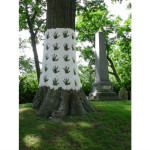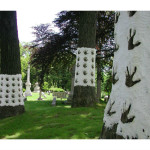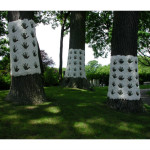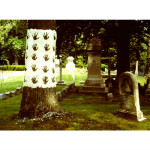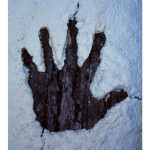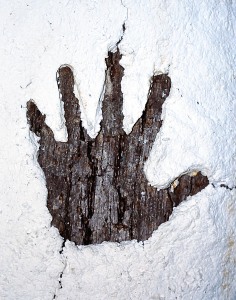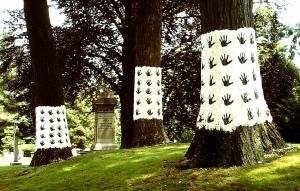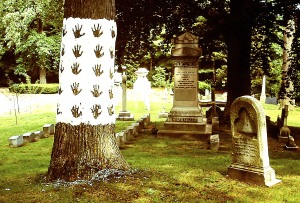- Ritual Trees, paper pulp
- Ritual Trees, paper pulp
- Ritual Trees, paper pulp
- Ritual Trees, paper pulp
- “Ritual Trees” (hand detail)
Situated in the Victorian era Forest Hill’s Cemetery, Ritual Trees’ paper pulp shrouds explore themes of commemoration and transformation. Reading the hand imprint and patterns carefully reveals a detailed portrait of the ritual and its participants.
The artist statement from the show's program
I am struck by the layers of history this landscape records, how the dated gravestones and monuments chronicle individual histories, how the old stone walls and mature plantings, thick with age, bear witness to the seasonal rites that have shaped the land. Signs of life’s ebb and flow are everywhere. The cemetery’s ancient trees, which have witnessed much of this history, seemed ideal to extend a series I have been working on for the past few years.
The Ritual Trees series relies on the hand as both image and tool. Unprotected by clothing, the bare hand connects us to the world through touch. Each piece in this series stands as an artifact of a process. Reading them carefully reveals a detailed portrait of the ritual and its participant.
“In 1848, Forest Hills Cemetery in Jamaica Plain was established, and since that time the site has become the final resting place of famous figures like poet e. e. Cummings and abolitionist William Lloyd Garrison. More than just a burial ground, however, Forest Hills is also home to a nationally-known collection of Victorian and early 20th century sculpture and architecture, set against a backdrop of stunning natural beauty.
Now, the Forest Hills Educational Trust is making an attempt to celebrate that natural beauty with ‘Spirits in the Trees,’ a multi-media exhibition of new installation art and sculpture that opens to the public today in Boston. Three MetroWest artists—Carol Spack of Framingham and Charles McQuillen and Janine Al-Bayati, both of Natick—are participating in the show. The three artists chosen, along with 20 other artists from a field of more than 100 submissions, have produced highly individual works of differing styles and materials.
‘My work is installation art, and usually the pieces I do are site-specific,’ says McQuillen. ‘In that spirit, I often work with whatever materials are at hand. If I am doing something outdoors in winter, I might use snow. Here I am making use of the trees of Forest Hills.”
McQuillen’s piece, Ritual Trees, involves a number of trees that have been wrapped in what McQuillen calls ‘a shroud of paper pulp.’ Within the paper shrouds are a series of handprints, made by McQuillen, that stretch from the bottom of the upward. ‘I thought it would be nice to use something white like this paper. To me, white recalls a lot of human rituals like weddings and baptisms.’
‘What I did was place my hand on the tree, then I took that thick, almost cottony paper pulp and packed it around my hand,’ he says. ‘When I was laying my hand on the tree I tried to do it in a way that I remember priests laying their hands on your head when they bless you in church.’…
‘In cemeteries I am always struck by the idea of ashes to ashes and dust to dust,’ says McQuillen. ‘I think that Forest Hills has that wonderfully transitory atmosphere for a temporary exhibition. I’ve always though that outdoor installation shows are great because galleries can be very sterile and elitist. A show like this will allow a lot more people to interact with the art—people who want to just take a walk in the sun and see lots of beautiful things for no expense.’…”
– Wardrop, Josh. “Spirits in the natural world: New outdoor exhibit features MetroWest artists,”
The Daily News. Framingham, MA. June 16, 2002.
“These days, not many people think of picnicking in a cemetery. We don’t usually go there to look at art, either, or to reconnect with nature, or to refresh our spirits. But our Victorian ancestors used cemeteries for all those purposes. And Cecily Miller thinks they were on to something.
The garden-style cemeteries of the 19th century, of which Boston’s Forest Hills is a superb example that remains remarkably invisible to many city residents, ‘were meant to be a place where people living in the stress and density of the urban environment could come and reconnect with nature,’ says Miller, the director of the Forest Hills Educational Trust. ‘That’s why they’re so beautifully landscaped.’
Miller, who came to Forest Hills last year after 14 years with the Somerville Arts Council, is particularly interested in reviving another Victorian custom: the use of cemeteries to display contemporary art. The elaborate tombstones and memorial sculptures of Forest Hills, she points out, were daringly modern for their time; people who cared about contemporary art used their family plots as a site for commissioning works from major American sculptors.
Though the era of fine-art commissions for gravestones is probably over, Forest Hills is finding other ways of embracing and celebrating contemporary art.
A ‘sculpture path’ opened last fall and will remain on view in its current form through the summer; other works may be added later on. And this weekend marks the opening of a temporary installation called ‘Spirits in the Trees,’ featuring 22 works inspired by the landscape and history of Forest Hills.…
Nearby, artist Charles McQuillen was creating another work that will weather and change as it stands. For Ritual Trees, he has applied wet paper pulp to the trunks of three oak trees, with a regular patterning of of handprints left uncovered. The rows of dark prints against the white pulp create a powerful totemic image, one that seems to echo and respond to the tombstones surrounding this little family of trees. ‘It’s a personal mark, but it’s also a patterning,” McQuillen said of the handprints, which he based on his own, his wife’s and their child’s. He suggested some of the abstract symbolism of his work: the meaning of white in various cultures, the ritual quality of repetitive images, the connection between the tree’s own life and the dead paper pulp applied to it.
But, like Sorg, he also spoke about the practical, real facts of what will happen to this work now that it’s there. ‘This piece should age over time,’ he said. ‘There’ll be stuff growing on it. You can already see ants and spiders crawling on it.’
When a viewer noted how well the work fit into a cemetery, with its themes of ritual commemoration and transformation, McQuillen smiled. ‘That’’s why you gotta love outdoor shows,’ he said. ‘You do this in a gallery and everybody says. ‘Yeah, all right.’ Here, people say, ‘Wow, your pretty intelligent!’ And you get a whole range of people that don’t normally look at art. There is a lot of pressure taken off here.’
For Miller, that’s one of the most valuable attributes of the cemetery as a place for art. Because casual strollers can come across art on their own here, she says, they can experience it without feeling intimidated by going into a gallery or museum.…”
– Kennedy, Louise. “Enchanted Forest: Exhibit connects with nature’s spirit at
Jamaica Plain cemetery,” The Boston Globe. Boston, MA. June 21, 2002.
Ritual Trees grew out of my earlier guerrilla installations. This ritual followed the same pattern as the original rituals. I placed my left hand directly on the trees and packed handfuls of the medium around it with my right hand. In this case the medium was a thick, wet, cottony paper pulp. Since this installation had to last the full summer, I needed a more durable medium than the previous rituals. As with the earlier rituals, I started in a kneeling position and continued upward until my arms were fully extended over my head. A close reading of the hand imprint and patterns provides a detailed portrait of the ritual. It likewise offers a detailed profile of the participant’s dimensions.
Unlike the previous rituals, this installation involved three different participants; me, my wife, and one of my toddler children. It seemed especially fitting to include a family ritual here, surrounded by family burial plots that spelled out family relationships based on the size and location of the headstones.
- Explain to students that reading this installation carefully reveals a detailed portrait of the ritual and its participants. Then, analyze the pictures of the piece and use an anchor chart to record their observations. Where is the installation situated? How many participants were involved in this ritual? How was the ritual performed? Physically reenact the gesture. Does the gesture remind you of anything?
- What is your initial response to what you see? What does it make you think of? Are there any elements from this ritual that are shared by rituals you have experienced? Color? Gesture? Setting (think sacred space, not just cemetery)?
- Read the artist statement and the reviews. Do these shape your understanding of the piece?
The use of rituals in environmental art
Some artists use rituals and religious symbolism to call attention to a site or an environmental issue. Consider how artists such as Red Earth, Dominique Mazeaud, Ana Mendieta, and Richard Solomon incorporate their own distinct rituals and spirituality in their work.

